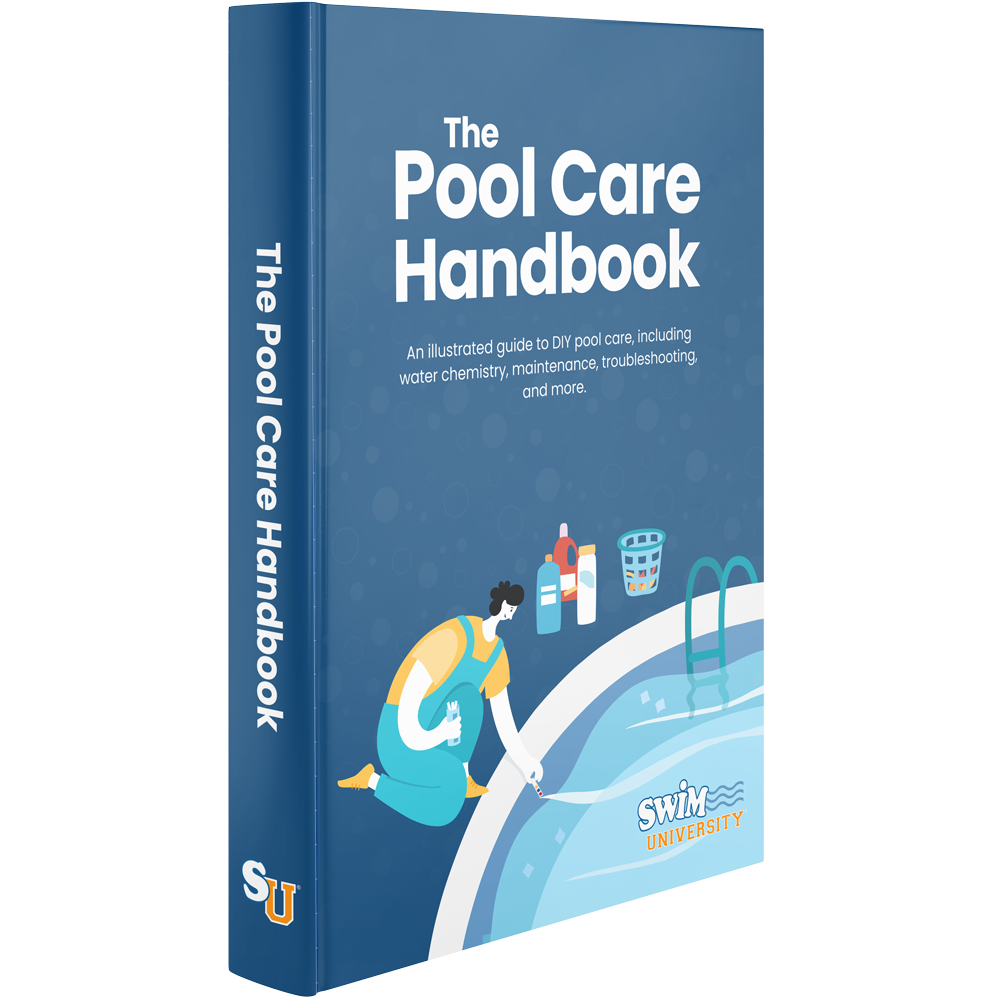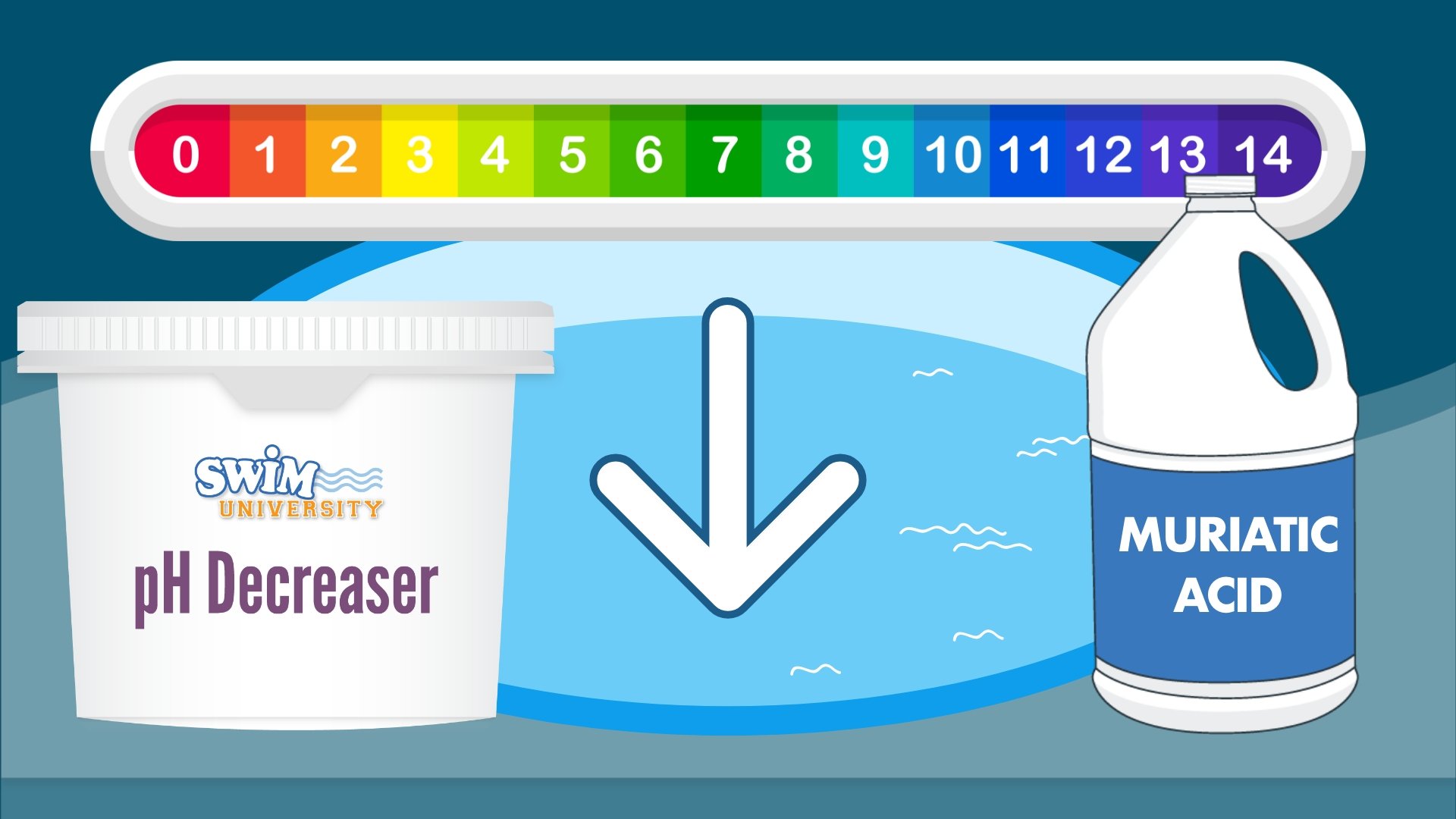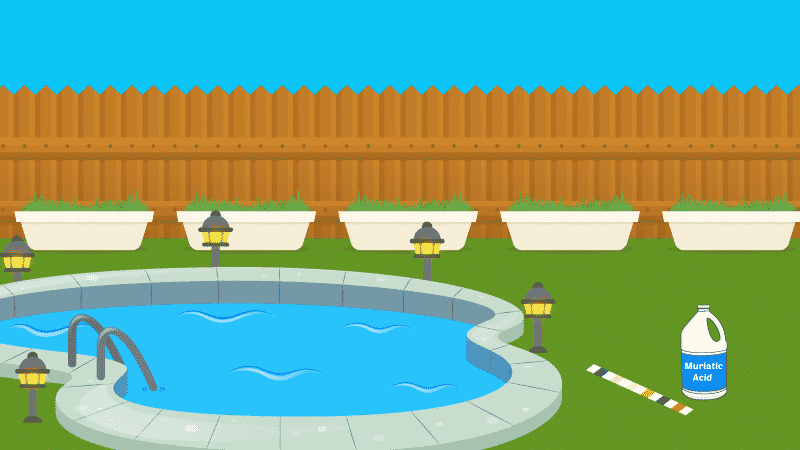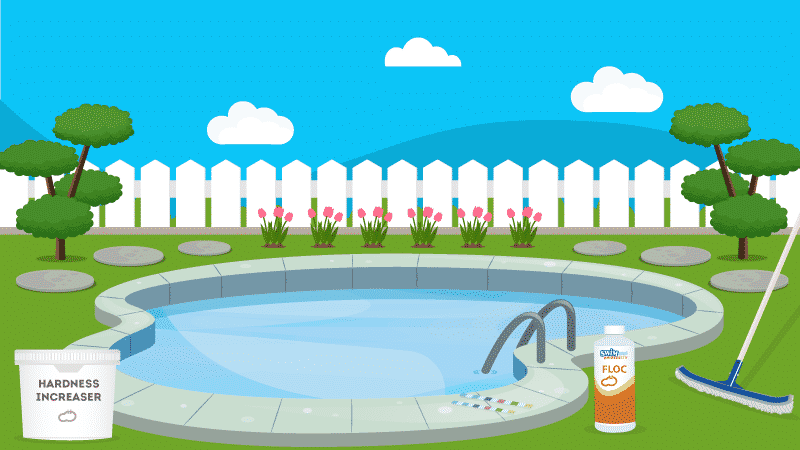Alkalinity Too High? Here’s How to Lower Alkalinity in a Pool Quickly
If you’ve noticed your total alkalinity is higher than 150 ppm, it’s an easy fix. To lower the alkalinity in a pool, use muriatic acid or sodium bisulfate (pH reducer). Here’s a quick guide explaining how alkalinity levels get too high and how to lower your alkalinity in a pool.
Check out the video below for how to lower your alkalinity with muriatic acid, or keep reading for our complete guide.
Stop wasting time and money with confusing water chemistry and maintenance. Our effortless system guarantees to keep your pool balanced, sanitized, and crystal clear all year. Works for all pools including saltwater.
What is Total Alkalinity?
Alkalinity buffers your pool water’s pH, helping to prevent drastic pH fluctuations. Balancing your total alkalinity is important to maintain consistent pH levels.
Your total alkalinity should be between 80 and 120 ppm (parts per million). And your pH should be between 7.2 and 7.8. Anything higher or lower will affect your pool’s ability to sanitize and damage your pool equipment.
How Do Alkalinity and pH Affect Each Other?
If your total alkalinity is too low, there’s not enough of this helpful buffering chemical in the water to help stabilize your pH. When your total alkalinity is too high, the elevated alkalinity may cause your pH level to rise. And that can reduce the effectiveness of the chlorine in your water.
So if your total alkalinity is in the normal range (100 to 150 ppm), your alkalinity will help stabilize your pH. And stabilized pH helps your chlorine do its job of sanitizing your swimming pool.
What Causes High Total Alkalinity?
Unfortunately, many pool chemicals you add to your water can impact your total alkalinity. Similarly, low chlorine levels and a high bather load can increase your pH and alkalinity levels.
Cyanuric Acid
Cyanuric acid (a.k.a. CYA or chlorine stabilizer) is the most common chemical that raises total alkalinity. CYA stabilizes your chlorine and prevents it from evaporating due to the sun’s UV rays. And it also acts as a buffer to the acidity caused by chlorine.
For example, stabilized trichlor chlorine has a pH of around 3. So when you use trichlor chlorine to sanitize your water, you make it more acidic. But because it’s stabilized, it contains cyanuric acid. And that buffers the acidity in your pool water. Buffered acidity can raise the alkalinity.
That’s why it’s so important to routinely test your pool water chemistry with test strips or a liquid test kit to ensure your levels remain properly balanced.
Low Sanitizer Levels
Another thing that can affect your alkalinity and pH is a high bather load in water with low chlorine. So if you have low chlorine levels and many swimmers in the water, they can leave behind contaminants that disrupt pH. And disrupted pH can disrupt the total alkalinity.
Pool Shock
You may also have issues with high alkalinity levels when you shock your pool. While it’s important to shock your pool on a regular basis, chlorine-based pool shocks are highly alkaline and will raise pH and, therefore, alkalinity. So, you may notice higher pH and total alkalinity after shocking your water.
This is the ultimate guide to keeping your pool sparkling clean throughout the year that contains everything you need to know about taking care of your pool the right way. Including saltwater pools.
What Happens if Your Pool Alkalinity is Too High?
Since alkalinity impacts pH, which in turn impacts almost everything in water, high alkalinity can cause a range of issues.
Causes High pH
If the alkalinity is too high, chances are your pH is too high. And if you have high pH, you may experience cloudy water and scaling. Plus scaling inside the pipes will restrict water flow, which puts a strain on your circulation and filtration system.
Reduces Chlorine Effectiveness
Total alkalinity levels affect your pH, which affects chlorine. And as a result, your pool’s chlorine will become less effective at sanitizing the water.
May Irritate Skin and Eyes
If the alkalinity and pH levels are off, swimmers can experience itchy skin and burning eyes. And it may also shorten the life of your bathing suit fabric and goggles.
Leads to Scale Build Up
Because high alkalinity disrupts the pH balance, it can lead to calcium buildup. And with high calcium, you may see scaling throughout your pool. You may also have visible calcium deposits collecting on the pool surface or calcium hardness buildup that you can’t see inside your pool equipment.
Creates Cloudy Water
High alkalinity can lead to calcium buildup. And high calcium levels in the water create cloudy pool water.
Clears cloudy pool water by combining particles, making it easier for your filter to remove. Great for all pools. Also compatible with salt water pools.
How to Lower Alkalinity in a Pool
There are two ways to lower total alkalinity: using muriatic acid or using a pH reducer, a.k.a. sodium bisulfate. Keep in mind that whichever method you use will also lower your pH levels. Check out our guide on how to lower pH in a pool for more information.
How to Use Muriatic Acid to Lower Alkalinity
Pool-grade muriatic acid is similar to hydrochloric acid, which is used to clean concrete and bricks but with a lower concentration of hydrogen chloride. It can help lower total alkalinity, remove calcium deposits, and clean filters. But it’s extremely corrosive and more dangerous to handle than sodium bisulfate.
Used for lowering alkalinity and pH in your pool water. It's also used for cleaning pool filter grids, filter cartridges, and concrete pool surfaces.
Because muriatic acid is an acid, always wear the appropriate safety equipment (including a mask to protect yourself from fumes) and follow the manufacturer’s directions on adding it to your pool. Even though muriatic acid is somewhat diluted, certain brands require you to dilute it further before adding it to your pool.
- Turn off your pool pump and wait until the water stops moving completely.
- Calculate how much muriatic acid you need to add to your water. As a general rule, it takes 25.6 ounces of full-strength muriatic acid to reduce the alkalinity in a 10,000-gallon pool by 10 ppm.
- Pour the muriatic acid into the deepest part of your pool.
- Turn on your pool pump and let it run for at least 5 hours before testing alkalinity again.
- After testing pool water alkalinity, retest your pH levels.
If you’re more concerned with lowering your pH than your alkalinity levels, here’s a chart to help you calculate how much muriatic acid to use.
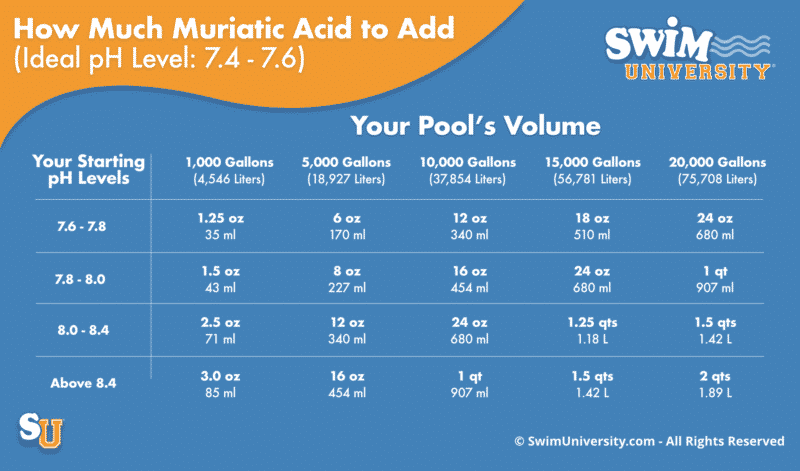
Lowering alkalinity with muriatic acid will take time. If your levels aren’t within range, you may need to repeat the process after a few days. And if your alkalinity levels were literally off the charts, it can take several rounds of adding muriatic acid for your levels to appear within range.
If you need more help using muriatic acid, be sure to check out our complete guide on how to safely use muriatic acid in your pool.
What if your pool’s pH drops too low? If your pool’s pH levels dip too low, you can raise your pH with aeration without impacting your alkalinity. Here’s a guide on how to raise your pH with an aerator. However, if you do aerate your pool, do this slowly and avoid over-aerating the water, as this can disrupt your pool chemistry even further.
How to Use Sodium Bisulfate to Lower Alkalinity
Sodium bisulfate, also known as acid salt or dry acid, is sold as pH down, pH reducer, pH minus, or pH decreaser. It works the same way as muriatic acid but it’s safer to use.
Use this chemical to lower just the pH level in your pool water.
However, though this method is safer to work with, it is more expensive. And you’ll still need to store the dry acid in a dry place protected from moisture.
Keep in mind that this will lower both your alkalinity and pH together, so be sure to retest both levels afterward.
- Follow the directions on the product to calculate how much to add to your pool water.
- Fill a bucket 3/4 of the way full with water and add sodium bisulfate.
- Use a wooden stick to mix the solution until the granules are completely dissolved. Undissolved granules may sink to the bottom of the pool and destroy its surface.
- Carefully pour the dissolved solution around the pool’s perimeter, starting with a deep end.
- Retest the alkalinity and pH of your water. If necessary, repeat the procedure.
Frequently Asked Questions About How To Lower Alkalinity in a Pool
Need more help bringing your alkalinity into range? Here are some common questions and answers.
How do I bring the alkalinity down in my pool?
A strong acid, such as muriatic acid or sodium bisulfate (pH decreaser), can reduce the total alkalinity in your pool. Pay attention to the directions on the bottle, measuring and mixing only what you need to bring your alkalinity levels back to the ideal range of 100 to 150 ppm.
What happens if the alkalinity is too high in a pool?
When the pool’s alkalinity is too high, the chlorine won’t sanitize the water as effectively. This can lead to calcium buildup, cloudy water, and irritation of swimmers’ eyes and skin.
How do you lower alkalinity without lowering pH?
Total alkalinity and pH are so closely related that it’s very challenging to lower the alkalinity without lowering pH. So, adding acid to the pool will reduce the total alkalinity, but it will also reduce your pH. If you need to raise the pH after using acid, you can aerate your pool water. This will bring the pH back up without affecting the alkalinity.
Does baking soda lower alkalinity in a pool?
No, baking soda will not lower your alkalinity levels. When you add baking soda or sodium bicarbonate to your pool water, it will raise both your alkalinity and pH. Baking soda is great for pool owners to have on hand as a substitute for an alkalinity increaser. And soda ash, a.k.a. sodium carbonate, is another option for raising your alkalinity and pH. But again, neither will lower high alkalinity levels.
4 Ways We Can Help With Your Pool
- Pool Care Cheat Sheets (Free): Easy-to-use downloadable guides to help you keep track of taking care of your pool this year.
- The Pool Care Handbook: An illustrated guide to DIY pool care, including water chemistry, maintenance, troubleshooting, and more.
- The Pool Care Video Course: You’ll get 30+ step-by-step videos and a downloadable guide with everything you need to know about pool maintenance.
- The Pool Care App: Enter your water test results. Get a custom treatment plan. Know exactly what chemicals to add to keep your pool clear.


